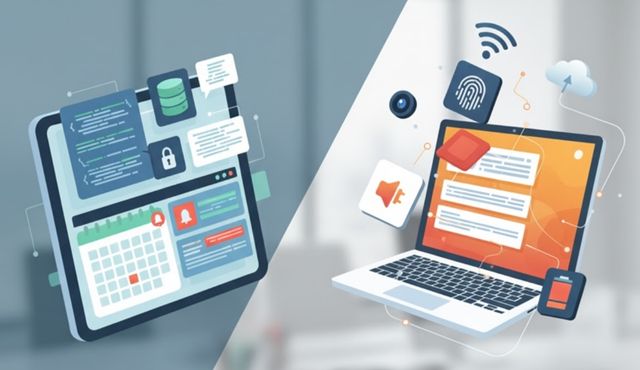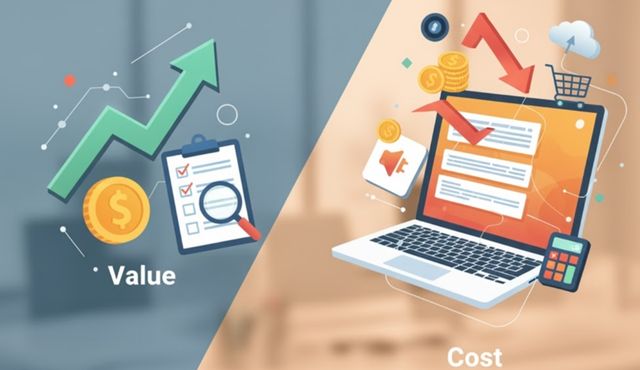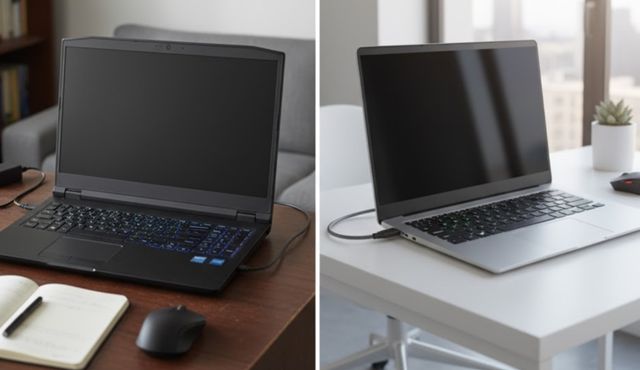Choosing the wrong 17-inch laptop could cost you hundreds of dollars and months of frustration. With budget models starting at $400 and premium options reaching $3,000, the performance gap is staggering.
Budget laptops offer basic functionality but often struggle with demanding tasks and show rapid depreciation. Premium models deliver exceptional performance, superior build quality, and better resale value over time.
This guide reveals the critical differences in processing power, construction quality, and long-term value that manufacturers don’t advertise. You’ll discover exactly when budget options make sense and when premium features justify their higher cost.
We’ll analyze real-world performance gaps, hidden ownership costs, and smart buying strategies. By the end, you’ll know precisely which category matches your needs and budget, potentially saving thousands on your next purchase.
Performance Differences That Matter
Budget 17-inch laptops typically feature entry-level processors like Intel Core i3 or AMD Ryzen 3 chips, paired with 4-8GB RAM and integrated graphics. These specifications handle basic tasks like web browsing, document editing, and light multitasking adequately, but struggle with demanding applications.
Premium models showcase high-end processors such as Intel Core i7/i9 or AMD Ryzen 7/9, combined with 16-32GB RAM and dedicated graphics cards. This powerful combination delivers exceptional performance for professional work, content creation, and gaming.
Processing Power Comparison
Budget processors operate at lower clock speeds and feature fewer cores, resulting in slower rendering times and limited multitasking capabilities. When you sell your used laptop models from this category, depreciation tends to be steeper due to rapidly outdated specifications.
Premium processors offer multiple cores with higher clock speeds, enabling smooth operation of resource-intensive software like video editing suites, 3D modeling applications, and modern games. These systems maintain better resale value over time.
Memory and Storage Solutions
Budget laptops often include traditional hard drives or smaller SSDs with limited capacity. Premium models feature high-speed NVMe SSDs with larger storage options, significantly improving boot times and application loading speeds.
Graphics Performance Analysis
Integrated graphics in budget laptops handle basic visual tasks but fall short for gaming or professional graphics work. Dedicated GPUs in premium laptops provide substantial performance improvements for gaming, video editing, and CAD applications.
Build Quality and Design Features
Construction materials represent a major differentiator between budget and premium 17-inch laptops. Budget models typically use plastic chassis that may feel flimsy and show wear quickly, while premium laptops feature aluminum or magnesium alloy construction for superior durability.
Keyboard and trackpad quality varies significantly across price ranges. Budget laptops often have shallow, mushy keys with basic trackpads, whereas premium models offer mechanical keyboards with precise key travel and responsive glass trackpads.
Display Technology Variations
Budget 17-inch laptops usually feature basic TN or entry-level IPS panels with limited color accuracy and brightness. Premium models showcase high-resolution displays with excellent color reproduction, often including features like touchscreen capability or high refresh rates.
Port Selection and Connectivity
Budget models provide essential ports but may lack modern connectivity options like Thunderbolt 4 or USB-C charging. Premium laptops offer comprehensive port selections including multiple USB-C ports, HDMI 2.1, and advanced wireless connectivity.
Thermal Management Systems
Budget laptops often struggle with heat dissipation, leading to thermal throttling during intensive tasks. Premium models incorporate sophisticated cooling systems with multiple fans and heat pipes for consistent performance.
Audio and Visual Enhancements
Premium laptops typically include superior speakers, better webcam quality, and advanced display technologies that budget models cannot match due to cost constraints. Considering a budget gaming laptop instead? Evaluate whether the build quality compromises align with your usage patterns and longevity expectations.
Software and Feature Comparisons

Operating system versions may differ between budget and premium laptops. Budget models sometimes include Windows Home editions with limited features, while premium laptops often come with Windows Pro, offering enhanced security and business capabilities.
Pre-installed software varies considerably across price points. Budget laptops frequently include bloatware that can slow system performance, whereas premium models typically offer cleaner installations with valuable productivity software.
Security Features Analysis
Budget laptops provide basic security features like password protection and Windows Defender. Premium models include advanced security options such as fingerprint readers, IR cameras for Windows Hello, and TPM chips for enhanced encryption.
Warranty and Support Services
Premium laptops usually include comprehensive warranty packages with priority support, on-site service options, and extended coverage periods. Budget models typically offer basic warranties with limited support channels.
Software Optimization Levels
Premium manufacturers often optimize software for specific hardware configurations, resulting in better performance and stability compared to generic installations found in budget laptops.
Update and Driver Support
Premium laptop manufacturers typically provide longer-term driver support and regular BIOS updates, ensuring better long-term compatibility and performance optimization. Looking to sell Dell laptop for cash or other premium brands? Their superior software support often translates to better resale values.
Value Analysis and Cost Considerations

Initial purchase price represents the most obvious difference, with budget 17-inch laptops starting around $400-800 while premium models range from $1,200-3,000 or more depending on specifications and brand positioning.
Total cost of ownership extends beyond initial purchase price. Budget laptops may require earlier replacement due to performance limitations or hardware failures, while premium models often provide longer service life with consistent performance.
Depreciation Patterns
Budget laptops depreciate rapidly, losing significant value within the first year. Premium models retain value better, making them more attractive when you need to sell your used laptop for an upgrade.
Repair and Maintenance Costs
Budget laptops may have higher long-term maintenance costs due to lower-quality components and limited warranty coverage. Premium models often include better warranties and more reliable components, reducing unexpected repair expenses.
Performance Per Dollar Analysis
Budget laptops offer basic functionality at low cost but may struggle with future software requirements. Premium models provide better performance per dollar over their extended lifespan.
Resale Value Considerations
Premium laptops typically maintain 40-60% of their original value after two years, while budget models may retain only 20-30%. This difference significantly impacts upgrade economics when you get instant cash for devices.
Thinking about buying a used budget laptop strategy? Factor in remaining warranty coverage and component condition when evaluating the total value proposition.
Frequently Asked Questions
Should I buy a budget or premium 17-inch laptop for college?
Budget 17-inch laptops work well for general college coursework involving writing, research, and basic applications. However, students in engineering, design, or computer science programs may benefit from premium models with better performance and durability for demanding software requirements.
Can I upgrade components in budget 17-inch laptops?
Most budget laptops offer limited upgrade options, typically allowing RAM and storage upgrades only. Premium models often provide better upgrade flexibility, though many modern laptops have soldered components that cannot be upgraded regardless of price category.
Is it worth buying a used premium laptop over a new budget model?
Used premium laptops can offer superior build quality, performance, and features compared to new budget models at similar prices. However, consider warranty coverage, battery condition, and remaining software support when making this comparison.
Budget or Premium Laptop: Weighing Cost Against Performance
Choosing between budget and premium 17-inch laptops ultimately depends on balancing your immediate financial constraints with long-term computing needs. Budget models serve basic users well but may require earlier replacement, while premium laptops offer better performance, durability, and resale value over extended periods.
Consider your specific usage requirements, upgrade timeline, and total cost of ownership rather than focusing solely on initial purchase price. The right choice varies by individual circumstances, but understanding these key differences ensures you make an informed decision that delivers the best value for your situation.


